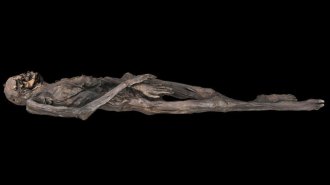A child’s ornate necklace highlights ancient farmers’ social complexity
It was likely buried around 9,000 years ago with a child who held significant social status

This impressive necklace, reassembled from beads, a pendant and a mother-of-pearl ring, was found in a child’s grave at an ancient Middle Eastern farming village. Black foam tubes replace poorly preserved beads in this reconstruction.
H. Alarashi et al/PLOS ONE 2023







